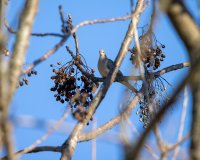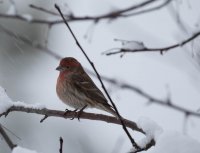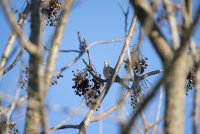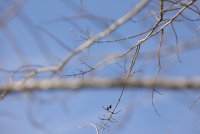I think I'm noticing this for the first time because I've rarely shot into trees with a lens that can go to 500mm, and now I'm doing it in all kinds of light.
I'm seeing, in the light shown in these pictures, a pretty consistent pattern of a LOT of blue around out-of-focus branches. I've applied lens corrections. For in-camera, would stopping down help? The two examples were taken "wide open" at f/7.1.
Note how I'm shooting upwards, and the light is coming in from fairly low in the sky and just over my right shoulder. If I weren't trying to photograph birds, I could change my position, etc., but birds don't hang around and pose like models...
Any tips for reducing in post processing?
Thanks!
This is interesting and I think there could be explanation for that.
Did you shoot RAW and if so where this files were procesed ? PS,LR, DXO or C1 ?
Last two could give a bit different and better results (especially C1) compared to the first two.
Could you provide RAW files so we could check them?
I think I could see here combination of several factors - might be including lens OOF performance itself, but mostly sharpening and clarity applied to OOF areas ( applied to the whole image and not selectivly to what is in focus). I think I see too much sharpening or clarity applied in OOF areas and this is what is causing your problem.
In C1 i would try to do the following:
1. Reduce a little bit sharpening or/clarity for the whole base image so that your problem (if exists in C1 - it is much better RAW converter than anything else) is less pronounced.
2. Create a layer , mask bird and areas in focus and apply local sharpnes, and clarity - (general and structure) to your taste. Make sure to have very smooth edge of the mask.
3. Duplicate layer, invert mask ( to select OOF areas) and reduce sharpnes, clarity and maybe contrast to minimize and possibly eliminate that problem that your described.
4. In case when you have strongly colored background (saturated blue sky) which create color casts/modulations on the transients you might need to desaturate transient areas - on separate layer. This could be done quickly using C1 color editor advanced tab, pick sky color with color picker, desaturate sky, apply luma range so that this affects only dark areas and not the sky itself ( sky will come back to normal) and all done.
In C1 using Wacom tablet all this above could be done in couple of minutes - depending how fast and precise your han with pen.
You can do the same in LR or DXO using local adjustments but is is much less efficient - much more to do.
In DXO you might need to reduce default lens sharpness - better to create preset or profile for that - by default DXO a bit aggressive on that.
Basically you need to make transitions between dark and light ares in OOF areas as smooth as possible without transients (or oscillations) visible on your image and remove blue cast in shadows.






